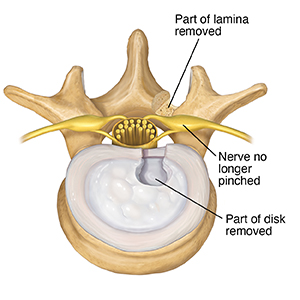Microdiskectomy
During a microdiskectomy, a portion of the disk (the cushion between the bones of your back) is removed. In most cases, bone must first be removed to expose the damaged disk. The part of the disk outer wall and soft center that presses on the nerve can then be removed. There is usually enough disk remaining to cushion the vertebrae.
Before your surgery
You will most likely arrive at the hospital on the morning of the surgery. Be sure to follow all of your healthcare provider’s instructions on how to get ready for surgery:
-
Follow any directions you are given for not eating or drinking before surgery.
-
If you take a daily medicine, ask if you should still take it the morning of surgery. If you take any blood-thinning medicines such as aspirin, warfarin, or clopidogrel, make sure you discuss them with your healthcare provider at least a week in advance.
-
At the hospital, your temperature, pulse, breathing, and blood pressure will be checked.
-
An IV (intravenous) line will be started to give you fluids and medicines needed during surgery.
During your surgery
-
Once in the operating room, you’ll be given anesthesia.
-
After you are asleep, you will be turned on your belly. Your skin will be disinfected, and sterile drapes will be placed. Then, an incision is made near the center of your low back. Your incision may be 1 to 6 inches long, depending on how many disks are involved.
-
In most cases, bone is removed from the vertebrae above and below the pinched nerve to expose the damaged disk. Removing bone may also take pressure off the pinched nerve.
-
During microdiskectomy, part of the disk outer wall and soft center that is pressing on the nerve is removed.
-
Once the nerve is free of pressure, the incision is closed with stitches or surgical staples.

After your surgery
After surgery, you’ll be sent to the PACU (postanesthesia care unit). When you are fully awake, you’ll be moved to your room or discharged from the hospital. The nurses will give you medicines to ease your pain. You may have a small tube (catheter) in your bladder. This tube will be removed before you go home. Soon, healthcare providers will help you get up and moving. You’ll also be shown how to clear your lungs.
When to call your healthcare provider
Once at home, call your healthcare provider if you have any of these symptoms:
-
Abnormal redness, heat, or fluid leaking at the incision site
-
More pain, numbness, or weakness in your leg
-
Fever of 100.4°F (38°C) or higher, or as advised by your provider
Online Medical Reviewer:
Anne Fetterman RN BSN
Online Medical Reviewer:
Heather M Trevino BSN RNC
Online Medical Reviewer:
Mahammad Juber MD
Date Last Reviewed:
4/1/2024
© 2000-2025 The StayWell Company, LLC. All rights reserved. This information is not intended as a substitute for professional medical care. Always follow your healthcare professional's instructions.